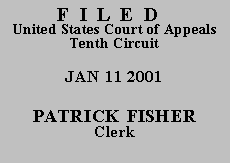

| JOE JORDAN, |
|
| v. | |
| JOE WILLIAMS, Warden, Lea County Correctional Facility; GARY JOHNSON; Governor, State of New Mexico; ROBERT PERRY, Secretary of Corrections; NEW MEXICO CORRECTIONS DEPARTMENT, State of New Mexico; WACKENHUT CORRECTIONS CORPORATION, a Florida corporation; LEA COUNTY; NEW MEXICO; ATTORNEY GENERAL FOR THE STATE OF NEW MEXICO, |
Mr. Jordan filed a pro se petition in the New Mexico district court for writ of habeas corpus pursuant to 28 U.S.C. § 2241, seeking an order vacating his conviction and sentence and granting his unconditional release. The magistrate judge issued a sua sponte show cause order for Mr. Jordan to explain why the petition should not be dismissed for failure to exhaust state remedies. After
consideration of Mr. Jordan's response to the show cause order, the district court dismissed the petition without prejudice. Mr. Jordan appealed. He also seeks a certificate of appealability pursuant to 28 U.S.C. § 2253(c).
In Montez v. McKinna, 208 F.3d 862, 864-65 (10th Cir. 2000), this court held that a habeas petition challenging a transfer to a privately run prison may be cognizable under § 2241. We made clear that a state habeas petitioner is generally required to exhaust state remedies when his action is brought under § 2241. See id. at 866. The prisoner in that case had failed to exhaust his state remedies, but we nevertheless rejected his challenge on the merits, relying upon 28 U.S.C. § 2254(b)(2) as analogous authority.
We also held that a certificate of appealability is required for a § 2241 appeal. See id. at 866-69. To obtain a certificate of appealability, a habeas petitioner must make a substantial showing of the denial of a constitutional right. See 18 U.S.C. § 2253(c)(2). This showing requires a demonstration that reasonable jurists could debate whether the petition should have been resolved in a different manner. See Slack v. McDaniel, 120 S. Ct. 1595, 1603-04 (2000). We conclude Mr. Jordan has failed to make this showing.
First, Mr. Jordan's state law claims are not cognizable in a federal habeas actions. See 28 U.S.C. § 2241(c)(3); Montez, 208 F.3d at 865. Further, to the extent Mr. Jordan challenges his transfer per se to a private facility pursuant to contract, such a claim is not cognizable under § 2241. See id. at 865-66; accord Rael v. Williams, 223 F.3d 1153, 1154 (10th Cir. 2000) (stating that fact that inmate is transferred to, or must reside in, a private prison, "simply does not raise a federal constitutional claim").(1)
Finally, to the extent Mr. Jordan raises cognizable federal constitutional claims, the district court properly dismissed his petition without prejudice for failure to exhaust. "Before a federal court may grant habeas relief to a state prisoner, the prisoner must exhaust his remedies in state court. In other words, the state prisoner must give the state courts an opportunity to act on his claims before he presents those claims to the federal courts in a habeas petition." O'Sullivan v. Boerckel, 526 U.S. 838, 842 (1999); accord Brown v. Shanks, 185 F.3d 1122, 1124 (10th Cir. 1999).
Accordingly, we DENY Mr. Jordan's request for a certificate of appealability and DISMISS this appeal.
Robert H. Henry
United States Circuit Judge
*. This order and judgment is not binding precedent, except under the doctrines of law of the case, res judicata, and collateral estoppel. The court generally disfavors the citation of orders and judgments; nevertheless, an order and judgment may be cited under the terms and conditions of 10th Cir. R. 36.3.
**. After examining the briefs and appellate record, this panel has determined unanimously to honor the parties' request for decision on the briefs without oral argument. See Fed. R. App. P. 34(f). The case is therefore submitted without oral argument.
1. We note that the district court did not have the benefit of our decisions in Montez and Rael, which we decided after the district court dismissed the petition.